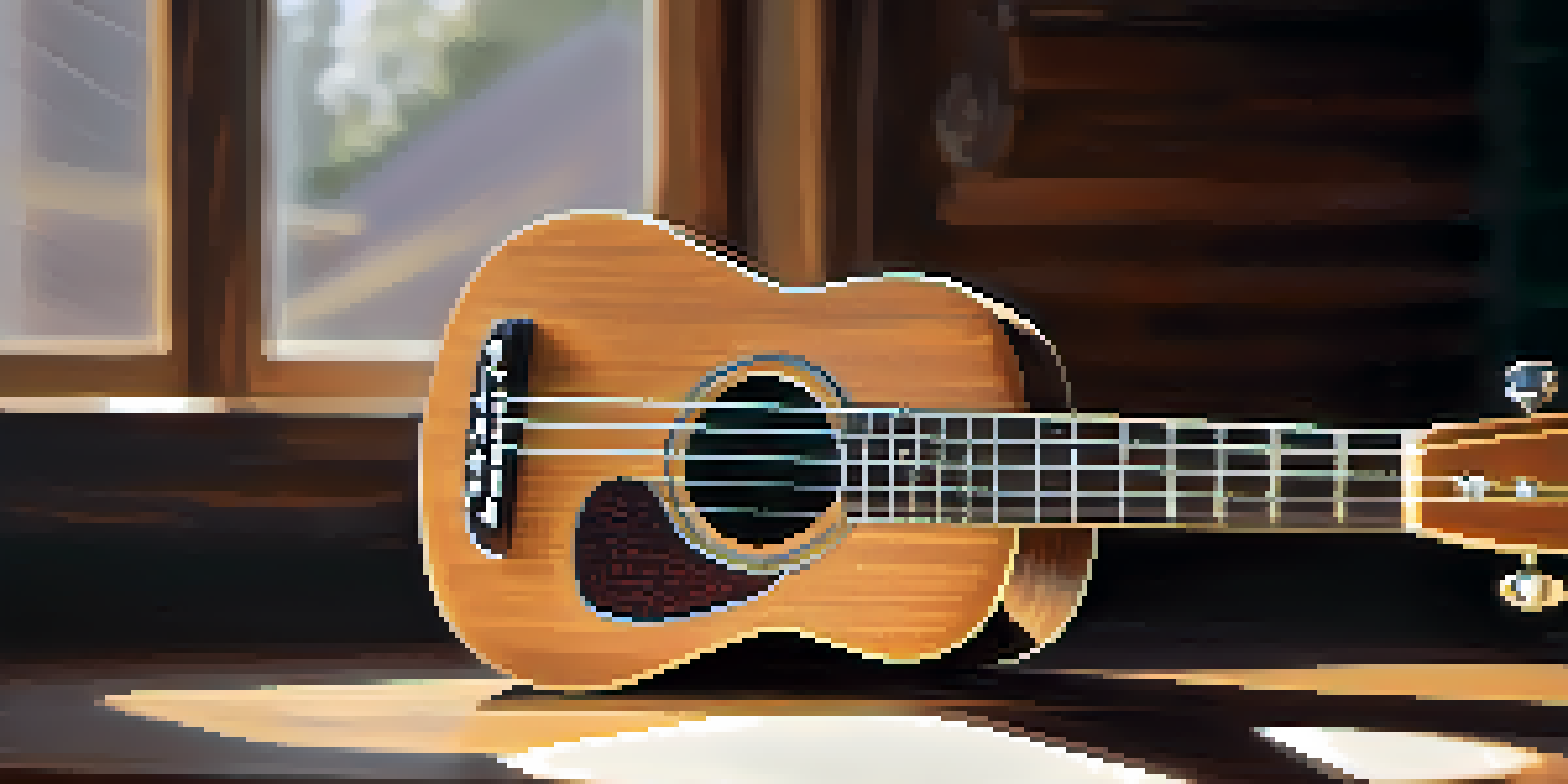Choosing the Right Microphone for Ukulele Recording

Understanding Different Microphone Types for Ukulele
When it comes to recording ukulele, knowing the types of microphones available is essential. The main types include dynamic, condenser, and ribbon microphones. Each type has its unique characteristics that can drastically affect the sound quality of your recordings.
The microphone is a tool for capturing sound, but it is also a tool for capturing emotion.
Dynamic microphones are known for their durability and resistance to high sound pressure levels, making them suitable for live performances. On the other hand, condenser microphones are more sensitive and capture a wider range of frequencies, which is ideal for studio recordings. Ribbon microphones offer a warm, vintage tone that some musicians prefer for acoustic instruments like the ukulele.
Choosing the right microphone type can enhance your ukulele's tonal qualities and pick up its unique sound nuances. Understanding these differences will help you make an informed decision tailored to your recording needs.
Factors to Consider: Budget and Quality
Budget plays a crucial role in selecting the right microphone for ukulele recording. There are high-quality options available at various price points, making it important to find a balance between cost and sound quality. A well-made microphone can significantly improve your recordings, but it’s vital to select one that fits your budget.

For beginners, entry-level microphones can provide satisfactory results without breaking the bank. As you progress, you might want to invest in more expensive models that offer superior sound capture and build quality. Researching reviews and recommendations can guide you toward the best options within your budget.
Know Your Microphone Types
Understanding dynamic, condenser, and ribbon microphones is key to enhancing your ukulele recordings.
Ultimately, remember that a higher price doesn't always guarantee better quality. It’s essential to assess what features are most important for your specific recording style and environment.
Microphone Polar Patterns: What to Know
Microphone polar patterns determine how a microphone captures sound from different directions. The most common patterns are cardioid, omnidirectional, and bidirectional. Understanding these patterns can help you choose a microphone that suits your recording setup.
Quality is not an act, it is a habit.
A cardioid microphone, which picks up sound primarily from the front, is excellent for isolating the ukulele from background noise. In contrast, an omnidirectional microphone captures sound equally from all directions, making it suitable for recording multiple instruments or a group of performers. Bidirectional microphones are less common but can be useful for duet recordings.
Choosing the right polar pattern can greatly impact the clarity and focus of your ukulele recordings. Consider your recording environment and the sound sources you want to capture when making your decision.
Microphone Accessories: Enhancing Your Setup
Investing in accessories can enhance your microphone's performance and usability. Essential accessories include pop filters, shock mounts, and microphone stands, all of which help improve sound quality and reduce unwanted noise. A pop filter can prevent plosive sounds, while a shock mount isolates the microphone from vibrations and handling noises.
Additionally, a good microphone stand will help position your microphone correctly, ensuring you capture the best sound possible from your ukulele. These accessories not only enhance your recordings but also contribute to a more professional setup.
Budget Wisely for Quality Gear
Finding the right balance between budget and sound quality is essential for selecting a microphone that meets your needs.
When choosing accessories, consider your recording space and how much mobility you need. The right tools will make your recording process smoother and more enjoyable.
Recording Techniques: Positioning Your Microphone
Once you've selected the right microphone, positioning it correctly is crucial for optimal sound capture. A common technique is to place the microphone about 12 to 18 inches away from the ukulele, angled slightly toward the sound hole. This distance allows the microphone to capture a balanced tone without overwhelming the recording with bass frequencies.
Experimenting with different positions can yield various sound profiles, so don’t hesitate to adjust the microphone's placement. For instance, moving it closer can bring out more detail, while placing it further away can create a more ambient sound. Every ukulele has its unique voice, and finding the right position will help showcase it.
Recording in a quiet space and eliminating unwanted noise can also enhance your recordings. Take your time to find the sweet spot for your microphone placement, and don’t be afraid to try different angles.
Testing Your Setup: The Importance of Sound Checks
Before diving into a recording session, conducting sound checks is essential. Testing your microphone setup allows you to assess the overall sound quality and make necessary adjustments. This process ensures that the final recording meets your expectations and captures the ukulele's true essence.
During the sound check, listen for any unwanted feedback, distortion, or background noise. Play a few chords and adjust the microphone position, gain levels, and EQ settings as needed. This step can save you time and frustration during the actual recording.
Importance of Sound Checks
Conducting sound checks before recording ensures optimal sound quality and captures the true essence of your ukulele.
Remember, a little preparation goes a long way. Taking the time to test your setup can lead to a more polished and professional-sounding recording.
Final Thoughts: Finding Your Unique Sound
Choosing the right microphone for ukulele recording is a personal journey that can greatly influence your sound. With various types, polar patterns, and accessories to explore, it’s essential to find what resonates with you and your musical style. Don’t shy away from experimenting to discover your unique sound.
Remember that recording is an art, and like any artist, you may need to try different tools and techniques to find what works best for your creative process. Learning from each recording session will help you refine your approach and enhance your skills over time.

Ultimately, the right microphone can elevate your ukulele recordings, bringing your music to life in new and exciting ways. Embrace the journey and enjoy the process of discovering your sound!